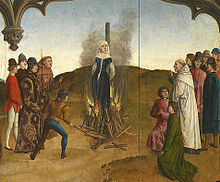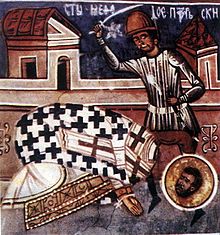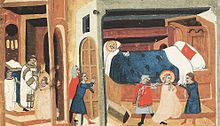† இன்றைய புனிதர் †
(செப்டம்பர் 18)
✠ புனிதர் ஜான் மசியாஸ் ✠
(St. John Macias)
டோமினிக்கன் துறவி/ பொதுநிலை சகோதரர்:
(Dominican Friar and Lay Brother)
பிறப்பு: மார்ச் 2, 1585
ரிபேரா டெல் ஃப்ரெஸ்னோ, எக்ஸ்ட்ரீமடுரா, ஸ்பெயின்
(Ribera del Fresno, Extremadura, Spain)
இறப்பு: செப்டம்பர் 16, 1645
லிமா, பெரு, புதிய ஸ்பெயின்
(Lima, Viceroyalty of Peru, New Spain)
ஏற்கும் சமயம்:
கத்தோலிக்க திருச்சபை
(Catholic Church)
முக்திபேறு பட்டம்: கி.பி. 1837
திருத்தந்தை பதினாறாம் கிரகோரி
(Pope Gregory XVI)
புனிதர் பட்டம்: கி.பி. 1975
திருத்தந்தை ஆறாம் பவுல்
(Pope Paul VI)
முக்கிய திருத்தலம்:
ஜெபமாலை அன்னை பேராலயம், லிமா, பெரு
(Basilica of Our Lady of the Rosary, Lima, Peru)
நினைவுத் திருவிழா: செப்டம்பர் 18
புனிதர் ஜான் மசியாஸ், 1620ம் ஆண்டு, பெரு (Peru) நாட்டில் சுவிசேஷ பணியாற்றிய ஒரு ஸ்பேனிஷ் டோமினிக்கன் துறவி (Spanish-born Dominican Friar) ஆவார். இவரது பிரதான உருவப்படம், லிமா (Lima) நகரிலுள்ள செபமாலை அன்னை பேராலய திருப்பலி பீடத்தில் அமைக்கப்பட்டுள்ளது. 1970ம் ஆண்டு, பெரு (Peru) நாட்டின் லிமா (Lima) நகரிலுள்ள “சேன் லூயிஸ்” (San Luis) எனுமிடத்தில், இவரை கௌரவிக்கும் விதமாக, இவர் பெயரில் ஒரு ஆலயம் கட்டப்பட்டுள்ளது.
“ஜுவான் டி ஆர்க்கஸ் ஒய் சான்செஸ்” (Juan de Arcas y Sánchez) எனும் இயற்பெயர் கொண்ட இவர், கி.பி. 1585ம் ஆண்டு, மார்ச் மாதம், 2ம் தேதியன்று பிறந்தார். இவரது பெற்றோரான “பெட்ரோ டி அர்காஸ்” (Pedro de Arcas) மற்றும் “ஜுவானா சேன்செஸ்” (Juana Sánchez) இருவரும் ஏழை விவசாயிகளாவர். நாலு வயதான இவரும் இவரது சகோதரி மேரியும் சிறுவர்களாக இருக்கையிலேயே இவரது பெற்றோர் மரித்துப் போயினர். சிறுவர்கள் இருவரையும் இவர்களது தாய்மாமன் வளர்த்தார். அவரது கடைசி பெயர் “மசியாஸ்” (Macias) ஆகும். சிறுவர்கள் இருவருமே தங்களது கடைசி பெயராக இப்பெயரையே ஏற்றனர். இவர்களது தாய்மாமன், ஜுவானை கால்நடைகள் மேய்க்க பயிற்றுவித்தார். ஜுவான் செபமாலை செபிப்பதிலேயே நீண்ட மணிநேரங்களை செலவிட்டார்.
ஜுவான், ஒருமுறை தமக்கு பதினாறு வயதாகையில், பக்கத்து கிராமமொன்றில் திருப்பலி காண போயிருக்கையில், டோமினிக்கன் துறவி ஒருவரை சந்திக்க நேர்ந்தது. தாமும் ஒரு டோமினிக்கன் ஆவதற்கான சாத்தியக்கூறுகளை கருத்தில்கொள்ள தொடங்கினார். தமது வாழ்க்கையில் கடவுளுடைய சித்தத்தை இவர் தேட ஆரம்பித்தபோது, இவரது பாதுகாவல் புனிதரான தூய யோவான் அப்போஸ்தலரும், அன்னை கன்னி மரியாளும் அடிக்கடி இவருக்கு காட்சியளித்ததாக கூறப்படுகிறது.
25 வயதான மசியாஸ், பின்னர் ஒரு பணக்கார தொழிலதிபருடன் பணிபுரியத் தொடங்கினார். அவர் இவரை தென் அமெரிக்காவிற்கு பயணிக்க வாய்ப்பளித்தார். “கொலம்பியாவின்” (Colombia) “கார்டகெனா டி இண்டியாஸுக்கு” (Cartagena de Indias) முதன் முதலாக வந்து சேர்ந்த இவர், பின்னர், "ரெய்னோ டி நியுவா கிரணடா" (Reino de Nueva Granada), "பாஸ்டோ" (Pasto), "கியூட்டோ" (Quito), "எக்குவடோர்" (Ecuador) ஆகிய இடங்களுக்கும், இறுதியில் கி.பி. 1619ம் ஆண்டு, பெரு (Perú) நாட்டின் லிமா (Lima) நகருக்கும் சென்றார். அங்கேயே தமது வாழ்நாளின் மீதமுள்ள காலத்தை கழித்தார்.
கி.பி. 1622ம் ஆண்டு, ஜனவரி மாதம், 23ம் நாளன்று, லிமா நகரின் “தூய மகதலின் மரியா” (St. Mary Magdalene) எனும் இடத்திலுள்ள டோமினிக்கன் துறவு இல்லத்தில் சேர்ந்தார். குருத்துவம் பெறாத பொதுநிலை சகோதரராக துறவு இல்லத்தில் சேர்ந்த ஜுவான், மறைபோதகம் செய்வதற்குப் பதிலாக, மடாலயத்தில் தேவையான உடல் உழைப்பைச் செய்யத் தொடங்கினார். ஒரு வருடம் கழித்து, கி.பி. 1623ம் ஆண்டு, ஜனவரி மாதம், 25ம் தேதியன்று, அவர் தனது இறுதி பிரமாணங்களை ஏற்றார். “தூய மகதலின் மரியா” துறவு மடத்தில் உதவி சுமை தூக்குபவராகவும் (Assistant Porter), வாயில் காப்பவராகவும் (Doorkeeper) பணி புரிந்த ஜுவான், மடத்தில் வாயிலிலேயே தங்கினார்.
செல்வந்தர்களுக்கும் ஏழைகளுக்கும் அறிவுரை:
ஜுவான் மசியாஸ், அவரது வாழ்க்கையின் இரண்டு பெரும் விடயங்களுக்காக மிகவும் அறியப்பட்டிருந்தார். முதலாவதாக, அவர் செபமாலை செபிப்பதில் பிரியமானவராக இருந்தார். குழந்தைப் பருவத்திலேயே ஸ்பெயின் நாட்டிலிருந்தபோது தொடங்கிய இப்பழக்கம், அவரது தாய்மாமனின் கால்நடைகளை மேய்க்கும்போதும் தொடர்ந்தது. இரண்டாவதாக, ஏழைகளின்பால் அவர் காட்டிய பெருந்தன்மைக்காக அவர் அறியப்பட்டார். அவர்களில் 200 பேருக்கு அவர் தினந்தோறும் உணவளித்தார். தமது ஒரு சிறிய கழுதையை லிமா நகர் முழுதும் அனுப்பி இவ்வுதவிப் பணிகளை செய்தார். இந்த கழுதையின் மேலே, ஏழை எளியவர்க்கு உதவுமாறு வேண்டி ஒரு சிறு பதாகை கட்டப்பட்டிருக்கும். கழுதை, தனது பாதையை முழுமையாக அறிந்திருந்தால், தெருக்களில் பயணம் செய்து நகரத்தின் ஏழைகளுக்கு வேண்டிய பொருட்களை ஏற்றிக்கொண்டு திரும்பிவரும். அடிக்கடி, கழுதை சில இடங்களில் நின்று, சத்தமாக சத்தமிடுவதால், வீடுகளின் உள்ளேயிருக்கும் மக்கள் தங்கள் நன்கொடைகளை செய்ய வெளியே வருவார்கள்.
துறவு மடத்தில், மசியாஸின் வாழ்க்கையானது, உற்சாகமான ஜெபம், அடிக்கடி தவம் மற்றும் கருணைப் பணிகளுடன் நிறைந்திருந்தது. இவரது கடின மற்றும் சிக்கன நடவடிக்கைகளின் விளைவாக, அவர் விரைவில் நோயுற்றார். மற்றும் ஆபத்தான அறுவை சிகிச்சை செய்ய வேண்டியிருந்தது. ஆயினும்கூட, அவர் துறவு மடத்தின் வாயில்களில் காத்திருந்த மற்ற நோயாளிகளின் கவனிப்பிற்கும் அவர் தொடர்ந்து புன்னகையுடன் கவனம் செலுத்தினார். யாசகர்களும், ஊனமுற்றோரும், மற்றும் பிற பின்தங்கிய நபர்களும் லிமா முழுவதும் காணப்படுகின்றனர். அவர்கள் ஆலோசனை மற்றும் ஆறுதலுக்காக மடாலய வாயில்களில் அவரிடம் திரண்டனர். ஏழைகள் உணவிற்காகவும், செல்வந்தர்கள் அறிவுரை மற்றும் ஆலோசனைகளுக்காகவும் அவரிடம் வந்தனர். இருப்பினும் மசியாஸ், மற்றவர்களுடன் உரையாடல் நடவடிக்கைகளில் ஈடுபடுவதைப் பற்றி சிந்திக்காமல், அதிக நேரத்தை தனிமையில் செபத்திலும் தவத்திலும் செலவழிக்க விரும்பினார். அவர் இதனை தமது மடத்தின் மடாதிபதி அருட்தந்தை “ரமிரேஸ்” (Father Abbot Ramírez) என்பவரிடம் ஒப்புக்கொண்டார். மடாதிபதி “ரமிரேஸ்” இவரைப்பற்றி பின்வருமாறு கூறுகிறார்.:
"அவர் கீழ்ப்படிதலையும் அவர் ஏற்ற பிரமாணங்களையும் ஒருபோதாவது பின்பற்றவில்லை என்றால், யாரும் அவரது முகத்தைக் கூட பார்த்திருக்கப்போவதில்லை."
ஆனால் 20 வருடங்களுக்கும் மேலாக அவர் செய்துவந்த துறவு மடத்தின் சுமைதூக்கும் பணி மற்றும் அவரது உத்தியோகபூர்வ நிலைப்பாடானது, தனிமையில் இயங்கும் தன் இயல்பான மனோபாவங்களுக்கு எதிரானது எனினும், அவர் தமது கீழ்ப்படிதலையும் தமது சத்திய பிரமாணத்தை ஒழுங்கமைப்பதையும் தொடர்ந்தார். இதுவே அவரை மகிழ்ச்சி நிறைந்த நிறைவேற்றத்துடன் நிரப்பியது. அவர் 1645ம் ஆண்டு, இயற்கையான காரணங்களால் மரித்தார்.
St. John Macias
September 18
Birth: 1585
Death: 1645
Dominican monk at Lima, Peru. He was born in Ribera, Spain, to a noble family and was orphaned at a young age. John went to Peru to work on a cattle ranch before entering the Dominicans at Lima as a lay brother, assigned to serve as a doorkeeper, or porter. He was known for his austerities, miracles, and visions. John cared for all the poor of Lima, dying there on September 16. Pope Paul VI canonized him in 1975 .
"Juan Macías" redirects here. For other uses, see Juan Macías (disambiguation).
John Macías, O.P. (Spanish San Juan Macias alt. sp Massias) (2 March 1585 Ribera del Fresno, Extremadura, Spain – September 16, 1645, Lima, Viceroyalty of Peru), was a Spanish-born Dominican Friar who evangelized in Peru in 1620. He was canonized in 1975 by Pope Paul VI. His main image is located at the main altar of the Basilica of Our Lady of the Rosary of Lima and is venerated by the local laity in Peru. A church was built in his honor in 1970 in San Luis, Lima, Peru.
Contents
1 Biography
2 Counsel to the rich and poor
3 Veneration
4 References
5 External links
Biography
He was born Juan de Arcas y Sánchez on March 2, 1585 in the small town of Ribera del Fresno, Extremadura which was under the jurisdiction of the Palencia Diocese, to Pedro de Arcas and Juana Sánchez. His parents were poor farmers; both died when Juan and his sister Mary were young. Juan was but four years old. The two children were raised by their uncle whose last name, “Macias,” they took as their own.[2] His uncle trained him as a shepherd. Juan would pass the long hours saying the rosary.
When he was about 16 years old, Macias met a Dominican friar while attending Mass in a neighboring village, and he began to consider the possibility of becoming a Dominican. It is said that as he began to seek God’s will for his life; he was frequently visited by the Blessed Virgin Mary and by his patron, St. John the Evangelist.[2]
At the age of 25, Macias then started working with a wealthy businessman who offered him an opportunity to travel to South America. He set out for the Americas in 1619,[3] arriving first at Cartagena de Indias, Colombia, then Reino de Nueva Granada, before stopping by Pasto and then Quito, Ecuador, and eventually arriving in Lima, Perú where he would remain for the rest of his life. Juan Macias was young when he set off as an emigrant for the new world. The ships which crossed the seas in those days carried all sorts of people: soldiers led by the lure of gold or glory; missionaries going to preach the Gospel; merchants and those seeking adventure; and also the poverty stricken hoping to find better luck.[4]
According to Father Vincent de Couesnongle, O.P., "[h]e knew what it meant to be uprooted and torn away from his natural surroundings, from everything he was used to. He knew what it is like to plunge into the unknown. He experienced the normal mixture of hopes and fears, and the difficulty of putting down roots and adapting to new ways. He was one of those millions of people who down through the ages have been shuttled from one country to another, not for the fun of it, or for adventure's sake, but because they had to."[4]
On 23 January 1622, Macias entered the Dominican Priory of St. Mary Magdalene in Lima. He entered as a lay brother, a non-ordained friar who, instead of preaching, would do the manual labor necessary in the monastery. One year later on 25 January 1623 he took his final vows. Macias was a contemporary of St. Martin de Porres who was in the Priory of Santo Domingo, (otherwise known as Holy Rosary). Juan was the assistant porter (doorkeeper) at St. Mary Magdalene and lived in the gatehouse.
Counsel to the rich and poor
Procession of Juan Macías
John Macias was well known mainly for two things during his life. First, he was known to love the rosary, which he began to pray as a child in Spain while he shepherded his uncle’s flock of sheep. Secondly, he was known for his generosity to the poor, 200 of whom he fed every day. He was greatly aided in this by a little donkey that he sent through Lima. He had a small sign put on it asking for donations for the poor. The donkey, knowing his route perfectly, would travel through the streets and come back with benefactions for the city’s poor. Often the donkey would stop at certain locations and make loud noises so that the people inside would come out to make their donations.[5]
At the priory, Macías's life was filled with fervent prayer, frequent penance and charity. As a result of his austerity, he quickly fell ill and had to have a risky surgery. Nevertheless, he continued to care for other sick and needy as they waited at the friary gates. Beggars, disabled people and other disadvantaged people were commonplace throughout Lima where they flocked to him at the monastery gates for counsel and comfort. The poor came for food, and the rich for advice.[6]
Macias, however, expressed a greater desire to spend more time in contemplative solitude rather than engage in conversational activities with others. He confessed this to Father Abbot Ramírez who said, “If he were to never follow his vow of obedience, nobody would have ever seen his face." But his official position as the priory's porter, which he held for over 20 years and went against his natural inclinations of solitude, served to continue disciplining his vow of obedience. This filled him with a joyful sense of fulfillment. He died of natural causes in 1645.
Veneration
Basilica and Convent of Santo Domingo in Lima, Peru where the remains of St. John Macias rest.
Several miracles were attributed to Macias during his life and after his death which led to his canonization. He was beatified, along with Martin de Porres, in 1837 by Pope Gregory XVI and canonized in 1975 by Pope Paul VI.[7][5] His feast day is September 18.
An annual public procession also takes place in Peru every third Sunday of November in Lima. Macias' image, along with that of the more famous saint, Martin de Porres, (his friend and fellow Dominican laybrother) are paraded around the streets and venerated by the faithful of Peru.












